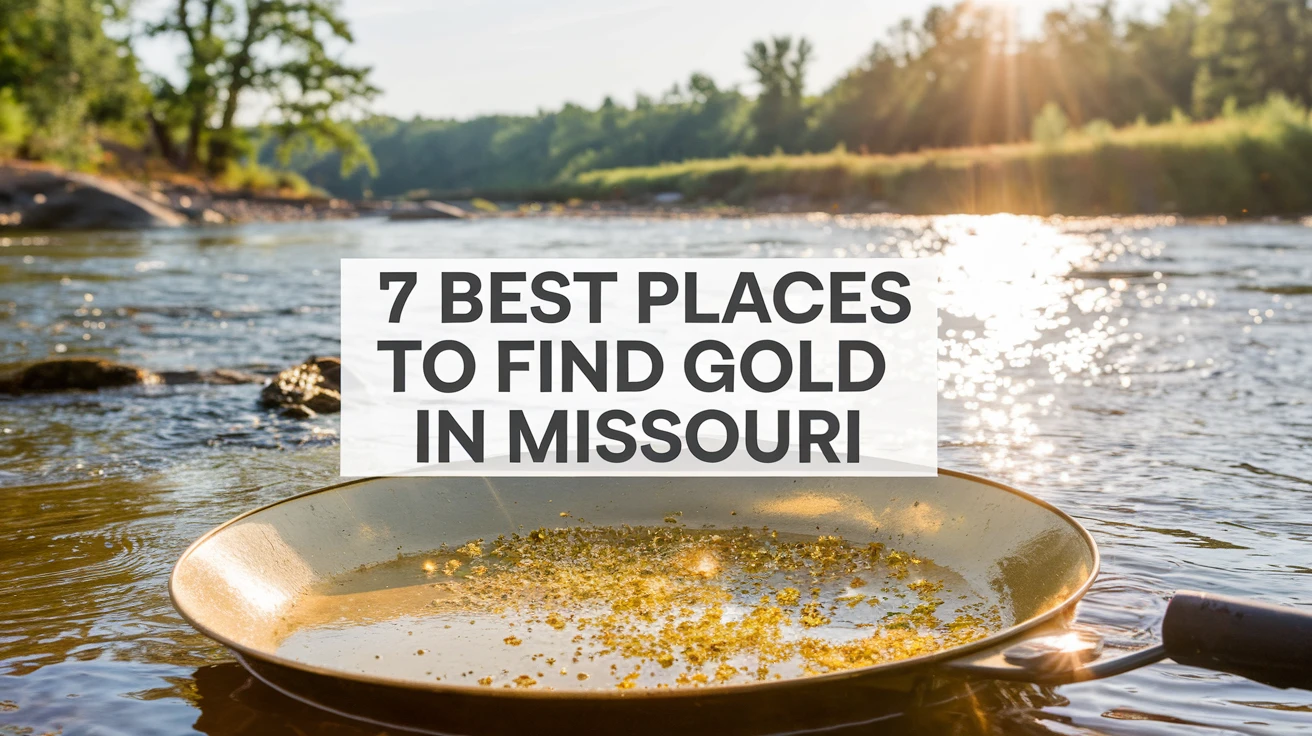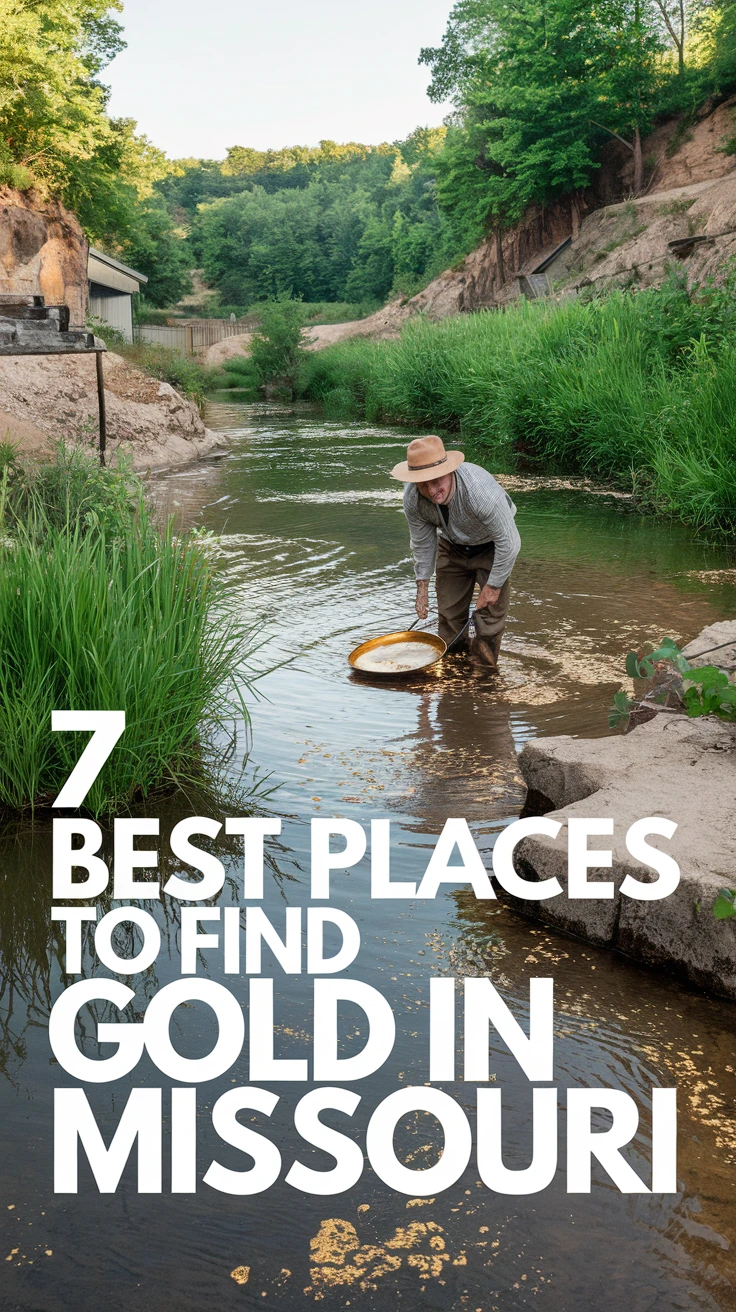
Missouri might not be the first state that comes to mind when you think of gold prospecting, but hidden within its streams and rivers lies a fascinating opportunity for adventure and discovery. While the Show-Me State isn’t known for massive gold deposits like California or Alaska, dedicated prospectors can still find placer gold in various locations throughout the state. As someone who’s spent countless weekends exploring Missouri’s waterways with a gold pan in hand, I can tell you that the thrill of finding even a small gold flake makes the entire experience worthwhile. In this comprehensive guide, we’ll explore the seven best locations where you can try your luck at finding gold in Missouri, along with essential tips and techniques to maximize your chances of success.
Understanding Missouri’s Gold History
Before we dive into specific locations, it’s important to understand that Missouri’s gold deposits differ from those found in traditional gold-rich states. Most of Missouri’s gold is glacial gold, deposited during the last ice age when glaciers carried gold-bearing material from Canada and northern states. This means the gold pieces are typically smaller, but they can be found in more numerous locations than you might expect.
Types of Gold Found in Missouri
| Gold Type | Characteristics | Common Locations |
|---|---|---|
| Placer Gold | Fine flakes and small nuggets | River bends and gravel bars |
| Glacial Gold | Very fine particles | Ancient glacial deposits |
| Lode Gold | Rare, embedded in rock | Quarries and mineral deposits |
7 Prime Locations for Gold in Missouri
1. Black River
The Black River, particularly near Clearwater Dam, has been one of my favorite spots for gold panning. The river’s consistent flow and numerous gravel bars create perfect conditions for gold accumulation. I’ve found that the best results come from working the inside bends of the river, especially after spring rains have moved new material downstream.
2. St. Francis River
Located in southeastern Missouri, the St. Francis River offers excellent opportunities for gold prospecting. The area around Sam A. Baker State Park has yielded some interesting finds. The river’s geology, with its ancient volcanic roots, makes it a prime location for both recreational prospectors and serious gold hunters.
3. Joachim Creek
This lesser-known spot in Jefferson County has been a reliable location for finding fine gold. The creek’s meandering path through historical mining areas makes it particularly interesting for prospectors. I’ve had success here during late summer when water levels are lower.
4. Big River
The Big River, especially near Bonne Terre, offers promising opportunities for gold panning. This area’s history of lead mining has created excellent conditions for finding placer gold in the river’s sediments. The old mining tailings often contain gold that was overlooked by early miners.
5. Meramec River
While primarily known for its recreational activities, the Meramec River holds secrets for patient prospectors. Focus on areas near old mining operations and confluence points with smaller streams. I’ve found that early spring, after the winter thaw, is particularly productive here.
6. Cuivre River
The Cuivre River area, particularly within Cuivre River State Park, offers good prospects for gold panning. The river’s numerous gravel bars and historical connection to glacial deposits make it a worthwhile destination for both beginners and experienced prospectors.
7. Mineral Fork Creek
This tributary of the Big River has been known to yield interesting finds. The creek’s name itself hints at its mineral-rich nature, and its relatively peaceful flow makes it an excellent spot for beginners to practice their panning techniques.
| Location | Best Season | Difficulty Level | Required Permits |
|---|---|---|---|
| Black River | Spring/Fall | Moderate | None on public access |
| St. Francis River | Summer | Easy | State Park permit |
| Joachim Creek | Late Summer | Moderate | Local permission |
| Big River | Spring | Easy | None on public access |
| Meramec River | Spring/Fall | Moderate | None on public access |
| Cuivre River | Summer | Easy | State Park permit |
| Mineral Fork Creek | Summer/Fall | Challenging | Local permission |
Essential Equipment for Missouri Gold Panning
Basic Equipment List
- Gold pan (12-14 inch recommended)
- Classifier sieve set
- Shovel (collapsible for portability)
- Snuffer bottle
- Vials for gold storage
- Tweezers
- Safety equipment (gloves, boots)
- First aid kit
Advanced Equipment Considerations
- Sluice box for processing more material
- Metal detector (for combining activities)
- Portable water pump
- Clean-up pan for final processing
- Magnifying glass for examining finds
Expert Tips for Successful Gold Panning in Missouri
Reading the River
Success in gold panning largely depends on your ability to read the river’s features. Look for these key indicators:
- Inside bends where water velocity decreases
- Natural barriers that trap heavy materials
- Bedrock outcroppings
- Areas downstream from historic mining operations
- Confluence points of streams
Seasonal Considerations
Each season offers different advantages and challenges for gold panning in Missouri:
| Season | Advantages | Challenges |
|---|---|---|
| Spring | Fresh deposits from spring rains | High water levels |
| Summer | Easy access to rivers | Low water levels |
| Fall | Comfortable temperatures | Variable conditions |
| Winter | Less competition | Cold temperatures |
Conclusion
Gold panning in Missouri offers a unique blend of outdoor adventure and potential rewards. While you might not strike it rich, the experience of connecting with nature and understanding the state’s geological history makes it a worthwhile pursuit. Remember to always respect private property rights, obtain necessary permits, and follow leave-no-trace principles. With the right location, proper equipment, and patience, you can join the growing community of Missouri gold prospectors who find satisfaction in this engaging hobby.
Key Takeaways
- Missouri’s gold is primarily glacial in origin, resulting in smaller but more widespread deposits
- The best locations combine historical mining areas with natural gold-trapping features
- Proper equipment and technique are more important than location for successful gold panning
- Seasonal timing can significantly impact your success rate
- Always obtain necessary permits and permissions before prospecting
Frequently Asked Questions
Do I need a permit to pan for gold in Missouri?
While many public waterways don’t require permits, some locations, especially state parks, may require permits or special permissions. Always check local regulations before starting.
What size gold can I expect to find in Missouri?
Most gold found in Missouri is fine flour gold or small flakes. Nuggets are rare but possible.
What’s the best time of year for gold panning in Missouri?
Spring and fall typically offer the best conditions, with moderate water levels and comfortable temperatures.
Can I keep the gold I find?
Yes, you can keep any gold you find on public lands where prospecting is allowed. However, always verify local regulations.
How much does it cost to start gold panning?
Basic equipment can cost between $50-100, making it an affordable hobby to begin.
Is it possible to make money gold panning in Missouri?
While possible, most people pan for recreation rather than profit. The amount of gold typically found makes it more suitable as a hobby.
What safety precautions should I take?
Always work with a partner, wear appropriate footwear, bring first aid supplies, and be aware of weather conditions and water levels.
How can I identify real gold from fool’s gold?
Gold is soft and won’t break when pressed with a needle, while pyrite (fool’s gold) is brittle. Gold also won’t lose its shine when in shadow.
What should I bring on my first gold panning trip?
Besides basic equipment, bring water, snacks, sun protection, bug spray, and a change of clothes.
Are there any gold prospecting clubs in Missouri?
Yes, several prospecting clubs operate in Missouri, offering meetings, group outings, and valuable knowledge sharing opportunities.

